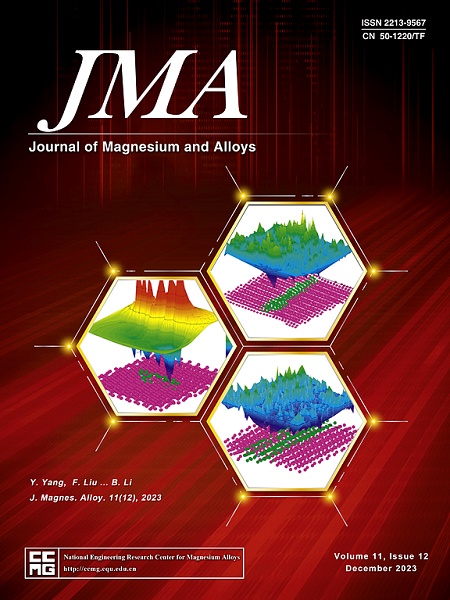在纯镁基质上直接生长的纳米结构MgO对其体外腐蚀和生物活性的影响
IF 15.8
1区 材料科学
Q1 METALLURGY & METALLURGICAL ENGINEERING
引用次数: 0
摘要
本研究介绍了一种在非水电解质中通过阳极氧化制备的纳米结构MgO涂层,为解决耐腐蚀性和生物功能的挑战提供了一种新方法。采用场发射扫描电镜(FESEM)、能量色散x射线能谱(EDX)和x射线衍射(XRD)对浸渍前后的表面进行了表征。电化学阻抗谱(EIS)和动电位极化测试表明,与未经处理的镁相比,耐腐蚀性降低了2倍。生物矿化研究表明,在模拟体液(SBF)中14天后,纳米结构表面形成了Ca/P比为1.35的磷灰石,超过了微结构MgO。Mg/MgO纳米结构的析氢量从912±38µL cm-2下降到615±32µL cm-2, Mg/MgO/HA纳米结构的析氢量从545±29µL cm-2下降。这些发现强调了纳米结构MgO涂层的潜力,通过提供增强的腐蚀保护,改善生物矿化,减少溶血和提高细胞活力,减少H2的产生,来推进mg基植入物。本文章由计算机程序翻译,如有差异,请以英文原文为准。

Effect of nanostructured MgO directly grown on pure magnesium substrate on its in vitro corrosion and bioactivity behaviour
This study introduces a nanostructured MgO coating fabricated via anodization in a non-aqueous electrolyte, offering a novel approach to addressing the challenges of corrosion resistance and biofunctionality. The surface was characterized before and after immersion testing using field emission scanning electron microscopy (FESEM), energy-dispersive X-ray spectroscopy (EDX), and X-ray diffraction (XRD). Electrochemical impedance spectroscopy (EIS) and potentiodynamic polarization tests demonstrated a 2-fold reduction in the corrosion resistance compared to untreated magnesium. Biomineralization studies demonstrated the uniform formation of apatite with a Ca/P ratio of 1.35 on the nanostructured surface after 14 days in simulated body fluid (SBF), surpassing that of microstructured MgO. Hydrogen evolution decreased from 912±38 µL cm-2 for untreated Mg to 615±32 µL cm-2 for the Mg/MgO nanostructure and 545±29 µL cm-2 for the Mg/MgO/HA sample. These findings highlight the potential of nanostructured MgO coatings to advance Mg-based implants by providing enhanced corrosion protection, improved biomineralization, reduced hemolysis and increased cell viability, and reduced H2 generation.
求助全文
通过发布文献求助,成功后即可免费获取论文全文。
去求助
来源期刊

Journal of Magnesium and Alloys
Engineering-Mechanics of Materials
CiteScore
20.20
自引率
14.80%
发文量
52
审稿时长
59 days
期刊介绍:
The Journal of Magnesium and Alloys serves as a global platform for both theoretical and experimental studies in magnesium science and engineering. It welcomes submissions investigating various scientific and engineering factors impacting the metallurgy, processing, microstructure, properties, and applications of magnesium and alloys. The journal covers all aspects of magnesium and alloy research, including raw materials, alloy casting, extrusion and deformation, corrosion and surface treatment, joining and machining, simulation and modeling, microstructure evolution and mechanical properties, new alloy development, magnesium-based composites, bio-materials and energy materials, applications, and recycling.
 求助内容:
求助内容: 应助结果提醒方式:
应助结果提醒方式:


